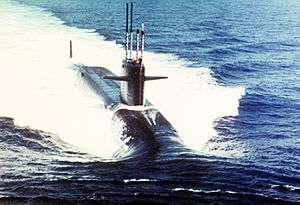USS Andrew Jackson (SSBN-619)
 USS Andrew Jackson (SSBN-619) | |
| History | |
|---|---|
| Name: | USS Andrew Jackson |
| Namesake: | Andrew Jackson (1767-1845), seventh President of the United States (1829-1837) |
| Ordered: | 23 July 1960 |
| Builder: | Mare Island Naval Shipyard, Vallejo, California |
| Laid down: | 26 April 1961 |
| Launched: | 15 September 1962 |
| Sponsored by: | Mrs. Estes Kefauver |
| Commissioned: | 3 July 1963 |
| Decommissioned: | 31 August 1989 |
| Struck: | 31 August 1989 |
| Motto: | One man with courage is a majority |
| Fate: | Scrapping via Ship-Submarine Recycling Program completed 30 August 1999 |
| Status: | Recycled |
| General characteristics | |
| Class and type: | Lafayette-class submarine |
| Type: | Ballistic missile submarine (hull design SCB-216)[1] |
| Displacement: |
|
| Length: | 425 ft (130 m) |
| Beam: | 33 ft (10 m) |
| Draft: | 31 ft 6 in (9.60 m) |
| Propulsion: |
|
| Speed: |
|
| Complement: | Two crews (Blue and Gold), 13 officers and 130 enlisted men each |
| Sensors and processing systems: | BQS-4 sonar[1] |
| Armament: |
|
USS Andrew Jackson (SSBN-619) was a Lafayette-class nuclear-powered ballistic missile submarine, it was the second ship of the United States Navy to be named for Andrew Jackson (1767–1845), the seventh President of the United States (1829-1837).
Construction and commissioning
The contract to build Andrew Jackson was awarded to Mare Island Naval Shipyard at Vallejo, California, on 23 July 1960 and her keel was laid down on 26 April 1961. She was launched on 15 September 1962 sponsored by Mrs. Estes Kefauver, and commissioned on 3 July 1963, with Commander Alfred J. Whittle, Jr. in command of the Blue Crew and Commander James B. Wilson in command of the Gold Crew.
Operational history
Following commissioning, Andrew Jackson sailed via the Panama Canal to the United States East Coast. On 1 October and 11 October 1963, during shakedown training out of Cape Canaveral, Florida, she successfully launched Polaris A-2 ballistic missiles; and, on 26 October 1963, she sent Polaris A-3X missiles into space in the first submerged launching of its type; and she repeated the feat on 11 November 1963. On 16 November 1963, six days before his assassination, President John F. Kennedy—embarked in the missile range instrumentation ship USS Observation Island (EAG-154)—observed Andrew Jackson launch another Polaris A-2 ballistic missile from a point off Cape Canaveral and congratulated Commander Wilson and his crew for "impressive teamwork."
Decommissioning and disposal
Andrew Jackson was decommissioned on 31 August 1989 and stricken from the Naval Vessel Register on the same day. Ex-Andrew Jackson entered the Nuclear Powered Ship and Submarine Recycling Program in Bremerton, Washington. Recycling of Ex-Andrew Jackson was completed 30 August 1999.
Notes
References
- This article incorporates text from the public domain Dictionary of American Naval Fighting Ships. The entry can be found here.
- This article includes information collected from the Naval Vessel Register, which, as a U.S. government publication, is in the public domain. The entry can be found here.
- NavSource Online Submarine Photo Archive: Andrew Jackson (SSBN-619) Keel Laying - Launching, retrieved 24 September 2011
- NavSource Online: Submarine Photo Archive Andrew Jackson (SSBN-619) Sea Trials / Decommissioning, retrieved 24 September 2011
- Kennedy Presidential Library Andrew Jackson Polaris Launch Photos, retrieved 26 April 2014